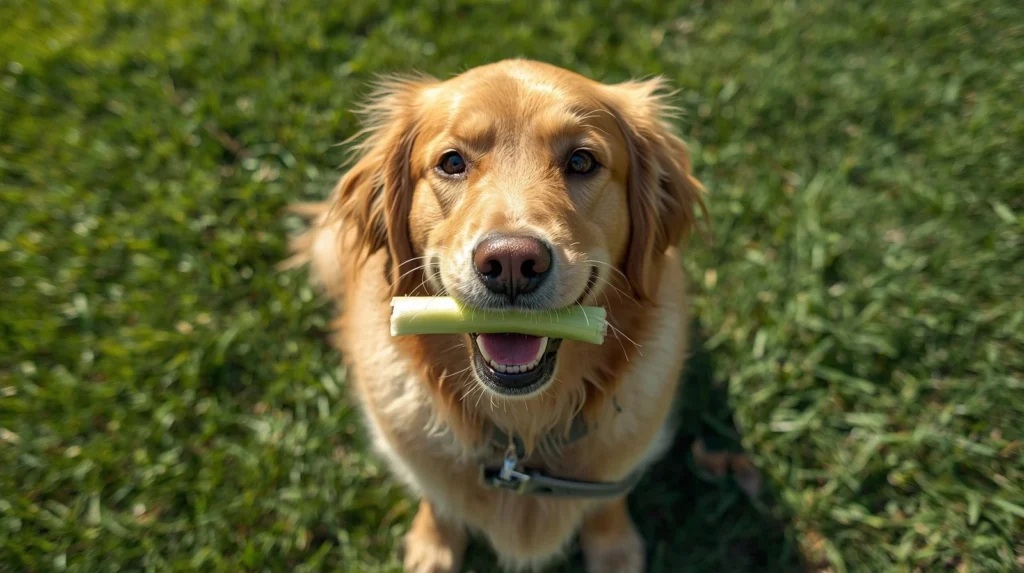Celery for Dogs: 5 Surprising Facts That Will Shock & Delight!
Table of Contents
- Introduction
- Nutritional Breakdown: What’s Inside Celery for Dogs?
- Top Benefits of Celery for Your Canine Companion
- Risks and When to Avoid Feeding Celery to Dogs
- How to Safely Prepare and Serve Celery to Your Dog
- Celery Parts and Preparation: What’s Safe?
- Serving Sizes & Frequency for Different Dog Sizes
- Creative & Fun Ways to Incorporate Celery into Your Dog’s Diet
- Frequently Asked Questions (FAQ)
- Conclusion
Introduction
Picture this: you’re munching on fresh, crispy celery sticks while your furry friend sits beside you with those irresistible puppy dog eyes, hoping for a taste of whatever delicious treat you’re enjoying. As a caring pet parent, you naturally wonder whether sharing this healthy human snack with your canine companion is safe.
The short answer is yes – dogs can eat celery in moderation, and it offers several nutritional benefits. This crunchy vegetable can be a healthy, low-calorie addition to your dog’s diet when prepared and served correctly.
This comprehensive guide will unpack everything you need to know about celery for dogs, covering the nutritional benefits, potential risks, safe preparation methods, and serving recommendations – all backed by veterinary expertise. Whether you’re looking to add variety to your dog’s treat repertoire or seeking healthier alternatives for weight management, understanding how celery fits into your pet’s nutrition plan is essential.
Throughout this article, you’ll discover the complete nutritional profile of celery, learn about specific health benefits for different dog breeds and sizes, understand when to exercise caution, and get practical tips for safe preparation. We’ll also explore creative ways to make celery more appealing to your four-legged friend and answer the most common questions pet owners have about this versatile vegetable.
Nutritional Breakdown: What’s Inside Celery for Dogs?

Celery stands out as a nutritional powerhouse that’s particularly well-suited for dogs due to its low-calorie, water-rich composition. Understanding what makes this vegetable beneficial helps explain why many veterinarians recommend it as a healthy treat option.
Water Content: Celery consists of approximately 95% water, making it an excellent hydration booster for dogs, especially during hot weather or for senior pets who may not drink enough water throughout the day.
The vitamin content in celery provides several specific benefits for canine health:
Vitamin A supports multiple bodily functions including vision health, immune system strength, skin integrity, muscle function, and proper nervous system operation. This fat-soluble vitamin is particularly important for growing puppies and aging dogs.
Vitamin C acts as a powerful antioxidant that promotes overall health and strengthens the immune system. While dogs naturally produce vitamin C in their bodies, additional dietary sources can provide extra support during stress or illness.
Vitamin K plays a crucial role in blood clotting mechanisms and bone health maintenance. This vitamin is essential for proper wound healing and skeletal development in growing dogs.
The mineral profile of celery offers additional health advantages:
Potassium helps maintain proper muscle and nerve function while potentially helping to lower blood pressure by offsetting excess sodium intake from other food sources.
Folate supports essential metabolic processes and proper cell function, making it particularly important for pregnant dogs and puppies in their growth phases.
Calcium contributes to strong bone development and maintenance throughout a dog’s life, supporting skeletal health from puppyhood through senior years.
Zinc strengthens the immune system, promotes proper digestion, and aids cognitive function – benefits that are especially valuable for working dogs and senior pets.
Manganese helps maintain proper blood sugar balance, reduces inflammation throughout the body, and promotes good bone health, contributing to overall metabolic wellness.
Fiber content in celery aids digestion and promotes a healthy gut microbiome, supporting regular bowel movements and overall digestive wellness.
The antioxidant compounds found in celery help minimize inflammation, fight disease-causing free radicals, protect cells from oxidative stress, and may provide support for dogs dealing with chronic conditions like cancer and arthritis.
Top Benefits of Celery for Your Canine Companion
Weight Management Support
One of the most significant advantages of incorporating celery into your dog’s diet is its potential for weight management. With approximately 10 calories per stick, celery provides a satisfying, high-fiber, water-rich snack that promotes feelings of fullness without adding excessive calories. This makes it an ideal treat for overweight dogs or those following veterinarian-supervised low-calorie diet plans.
The high fiber and water content help dogs feel satisfied while consuming fewer calories, making celery an excellent replacement for calorie-dense commercial treats during training sessions or reward-based activities.
Expert Insight: While celery can be a valuable tool in weight management, it’s important to understand that it serves as a dietary supplement rather than a complete solution for weight loss. Effective weight management for dogs requires comprehensive veterinary supervision, a balanced diet plan, appropriate exercise routines, and regular monitoring.

Dental Health Benefits
The natural crunchy texture of raw celery can help mechanically scrub plaque buildup from your dog’s teeth while providing a satisfying chewing experience. The fibrous nature of celery can also help freshen breath naturally, though it should never replace proper dental care routines including regular brushing and professional cleanings.
Digestive Health Enhancement
Celery’s high fiber content plays a crucial role in promoting healthy digestion and regular bowel movements. The insoluble fiber helps add bulk to stool while supporting beneficial gut bacteria, making it particularly helpful for dogs experiencing mild constipation issues.
Hydration Boost
With its impressive 95% water content, celery contributes significantly to your dog’s overall hydration needs. This benefit is especially valuable during hot summer months, for dogs who don’t drink adequate water independently, or for senior dogs who may be prone to dehydration.
Joint Health Support
The antioxidants found in celery, including flavonoids and Vitamin C, can help reduce inflammation throughout the body, potentially improving bone and joint health. This anti-inflammatory effect may be particularly beneficial for senior dogs or breeds prone to joint issues like hip dysplasia or arthritis.
Expert Insight: The principle of individualized dietary care for joint support applies across species – just as nutritional management benefits horses with joint concerns, dogs can also benefit from anti-inflammatory foods like celery as part of a comprehensive joint health strategy.
Blood Pressure Regulation Potential
The potassium content in celery helps offset excess sodium intake, potentially supporting healthy blood pressure regulation. This benefit may be particularly valuable for dogs with cardiovascular concerns or those on medications that affect blood pressure.
Cholesterol Level Support
The antioxidant compounds in celery may help support healthy cholesterol levels, contributing to improved cardiovascular health and overall wellness in dogs of all ages.
Risks and When to Avoid Feeding Celery to Dogs
While celery offers numerous benefits, responsible pet owners must understand potential risks and situations where caution is necessary.
Choking Hazard Concerns
Large, uncut, or improperly prepared fibrous pieces of celery pose a significant choking risk, particularly for small dog breeds, puppies with developing teeth, or brachycephalic breeds (such as pugs, bulldogs, and French bulldogs) whose shortened airways make them more susceptible to breathing difficulties.
Digestive Upset Possibilities
Excessive fiber intake from too much celery can lead to uncomfortable digestive symptoms including gas, bloating, diarrhea, or vomiting. Dogs with sensitive stomachs may experience these symptoms even with moderate amounts.
Allergic Reaction Monitoring
Though allergic reactions to celery are rare in dogs, pet owners should monitor for symptoms including itching, swelling around the face or paws, digestive upset, or changes in behavior after introducing celery to their dog’s diet.
Specific Health Conditions Requiring Caution
Gastrointestinal Problems: Dogs with chronic digestive issues, inflammatory bowel disease, or sensitive stomachs may find celery’s fiber content challenging to process, potentially exacerbating existing symptoms.
Kidney Problems: The relatively high potassium content (approximately 260 mg per 100g) can be problematic for dogs with kidney disease, as compromised kidneys may struggle to process excess potassium effectively.
Poor Appetite or Underweight Dogs: Celery’s low-calorie, high-fiber nature makes it unsuitable for dogs who need nutrient-rich, high-calorie diets to maintain or gain healthy weight.
Puppies: Young dogs have delicate gastrointestinal tracts and small teeth/jaws that require extra caution when introducing new foods. Puppies should only receive very small, softened pieces of celery.
Pesticide Residue Concerns
Always wash celery thoroughly before serving to remove potential pesticide residues, dirt, and bacteria. Consider choosing organic celery when possible to minimize chemical exposure.
How to Safely Prepare and Serve Celery to Your Dog
Proper preparation is essential for safely incorporating celery into your dog’s diet. Follow these step-by-step guidelines to ensure your pet can enjoy this healthy treat safely:
Step-by-Step Preparation Guide
- Wash Thoroughly: Rinse celery stalks under clean, running water to remove pesticides, dirt, bacteria, and any surface contaminants that could harm your dog.
- Remove Fibrous Strings: Carefully peel away the tough, stringy fibers that run along the outside of celery stalks. These strings are crucial to remove as they can be difficult to digest and may pose a choking hazard.
- Cut into Small, Manageable Pieces: Slice celery into appropriately sized pieces based on your dog’s size. Even large dogs should receive celery in pieces no larger than one inch to prevent choking and make chewing easier.
- Special Puppy Preparation: For puppies, either smash celery pieces into very fine bits or lightly steam them to soften the texture, making them safer for developing teeth and sensitive digestive systems.
- Serve Plain: Never add salt, pepper, onions, garlic, butter, or any other seasonings to celery intended for dogs. These additives can be toxic or harmful to canine health.
- Introduce Gradually and Monitor: Start with very small amounts and closely observe your dog for any signs of digestive discomfort, allergic reactions, or behavioral changes. If any adverse reactions occur, discontinue feeding celery immediately and consult your veterinarian.
- Practice Moderation: Remember that treats, including healthy options like celery, should comprise no more than 10% of your dog’s total daily caloric intake to maintain nutritional balance.
Celery Parts and Preparation: What’s Safe?
Can Dogs Eat Celery Stalks/Stems?
Yes, celery stalks and stems are safe for dogs when properly prepared. They must be thoroughly washed, have fibrous strings removed, and be chopped into appropriate sizes for your dog’s breed and age.
Can Dogs Eat Celery Leaves?
Celery leaves are not recommended for regular feeding to dogs. While not technically toxic, these leaves are concentrated in nitrates, essential oils, and oxalic acid, which can upset sensitive stomachs, taste bitter to most dogs, and are harder to digest than the stalks. If you choose to offer celery leaves at all, provide only tiny, finely chopped, thoroughly washed amounts, and monitor closely for any adverse reactions, especially in dogs with sensitive digestive systems.
Can Dogs Eat Celery Seeds?
Avoid giving celery seeds to dogs. The concentrated compounds in celery seeds can have unpredictable effects on dogs, potentially interacting with blood pressure medications, increasing urination significantly, and leading to dehydration. The concentrated nature of these seeds makes them too potent for safe canine consumption.
Should Celery Be Served Cooked or Raw?
Both raw and cooked celery can be safe options for dogs, each offering unique benefits:
Raw Celery: Provides the satisfying crunch that many dogs love while helping to mechanically clean teeth and freshen breath. Raw celery retains all its natural nutrients and provides the most dental health benefits.
Cooked Celery: Offers a softer texture that’s more manageable for senior dogs or those with dental issues. When cooking celery for dogs, it must be prepared completely plain without any seasonings, oils, or additives. Keep in mind that some heat-sensitive nutrients may be reduced during the cooking process.
Serving Sizes & Frequency for Different Dog Sizes
Determining appropriate serving sizes ensures your dog receives celery’s benefits without overconsuming treats. The general rule is to keep all treats, including healthy options like celery, under 10% of your dog’s total daily caloric intake to maintain proper nutritional balance.
| Dog Size | Recommended Serving Size | Frequency |
|---|---|---|
| Extra-Small (under 10 lbs) | 1-2 small pieces (½-inch) | 2-3 times per week |
| Small (10-25 lbs) | 1-2 small pieces | 2-3 times per week |
| Medium (25-60 lbs) | 2-3 small pieces | 2-3 times per week |
| Large (60-90 lbs) | 3-4 small pieces | 2-3 times per week |
| Extra-Large (over 90 lbs) | A small handful (1-inch pieces) | 2-3 times per week |
These recommendations provide a starting point, but individual dogs may have different tolerance levels based on their health status, age, activity level, and digestive sensitivity. Always observe your dog’s response and adjust accordingly.
Creative & Fun Ways to Incorporate Celery into Your Dog’s Diet
Healthy Training Treats
Use small celery pieces as low-calorie alternatives to commercial training treats, especially beneficial for dogs requiring frequent rewards during obedience training or behavior modification programs.
Nutritious Mix-Ins
Finely chop celery and mix small amounts into your dog’s regular food to add extra crunch, nutrients, and variety to their daily meals.
Frozen Delights
Create refreshing summer treats by freezing small celery pieces in water or low-sodium, dog-safe broth. These frozen treats provide hydration and entertainment, particularly valuable during hot weather.
Dog-Friendly “Ants on a Log”
Stuff celery sticks with plain, unsalted peanut butter (always verify it’s xylitol-free) or plain cottage cheese to create an engaging, nutritious snack that provides mental stimulation along with nutrition.
Dog Celery & Watermelon Cubes Recipe
For a special summer treat, create frozen cubes by blending small pieces of celery with seedless watermelon and freezing the mixture in ice cube trays. This combination provides hydration, vitamins, and a refreshing taste most dogs enjoy.
Consider creating visual comparisons between celery and other dog-safe vegetables like carrots, green beans, and sweet potatoes. Understanding how different vegetables compare in terms of nutritional benefits, preparation requirements, and appropriate serving methods helps pet owners make informed decisions about variety in their dog’s diet.
Frequently Asked Questions (FAQ)
Can dogs eat celery raw? Yes, dogs can safely eat raw celery when it’s properly prepared with strings removed and cut into small, appropriate pieces for their size.
Is celery good for overweight dogs? Yes, celery can be an excellent low-calorie, high-fiber, hydrating treat option for overweight dogs. However, it should be used as part of a comprehensive, veterinarian-supervised weight management plan rather than as a standalone solution.
Can puppies eat celery? Yes, puppies can eat celery with extra caution and preparation. Celery for puppies should be finely smashed or lightly steamed to soften the texture, served in very small amounts, and offered only a few small pieces once or twice per week.
How much celery can I give my dog? The appropriate amount depends on your dog’s size and individual tolerance. Refer to the serving guide table provided earlier in this article, and remember to keep all treats under 10% of your dog’s total daily caloric intake.
Is celery safe for all dogs? No, celery is not appropriate for all dogs. Dogs with kidney disease, extremely sensitive stomachs, or those prone to choking should avoid celery or use it only with extreme caution and veterinary guidance. When in doubt about your dog’s specific health needs, always consult your veterinarian.
What should I do if my dog has an adverse reaction to celery? If your dog experiences any adverse reaction to celery, immediately stop feeding it and contact your veterinarian for guidance. Monitor for symptoms such as vomiting, diarrhea, excessive gas, difficulty breathing, or changes in behavior.
What are other safe vegetables for dogs? Other dog-safe vegetables include carrots, green beans, sweet potatoes, and plain cooked pumpkin. As with celery, all new vegetables should be introduced slowly and in moderation, with proper preparation to ensure safety.
Conclusion
Celery can indeed be a valuable addition to your dog’s treat repertoire, offering impressive nutritional benefits including hydration support, digestive health promotion, weight management assistance, and joint health support through its rich vitamin, mineral, and antioxidant content. This low-calorie, water-rich vegetable provides an excellent alternative to high-calorie commercial treats while contributing meaningful nutrients to your pet’s diet.
However, the importance of caution cannot be overstated. Proper preparation – including thorough washing, string removal, and appropriate sizing – is essential for safe consumption. Moderation remains key, with celery treats comprising no more than 10% of your dog’s daily caloric intake. Always monitor your pet for any adverse reactions when introducing celery or any new food item.
Remember that every dog is unique, with individual dietary needs, health considerations, and tolerance levels. What works well for one dog may not be appropriate for another, particularly for pets with existing health conditions, kidney problems, or sensitive digestive systems.
When in doubt about whether celery is appropriate for your specific dog, always consult your veterinarian. Professional guidance ensures that dietary choices support your pet’s individual health needs and contribute positively to their overall wellness and quality of life.
Your commitment to understanding safe, healthy treat options demonstrates the thoughtful care that strengthens the bond between you and your canine companion while supporting their long-term health and happiness.
There are no reviews yet. Be the first one to write one.


